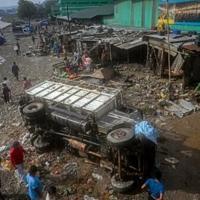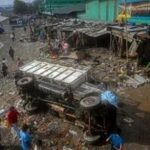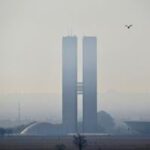Rescue teams in Nepal’s capital are currently investigating damaged homes after the waters receded from monsoon floods that led to the death of at least 209 people in the Himalayan republic.
Deadly floods and landslides are typical in South Asia during the monsoon season from June to September, but experts argue that climate change is exacerbating these natural disasters.
Several neighborhoods in Kathmandu were submerged following the heaviest rainfall in over two decades, temporarily isolating the capital from the rest of Nepal due to blocked highways caused by landslides.
The Home Ministry in Nepal reported 209 casualties across the country with 29 individuals still missing.
“We have escalated aerial rescue missions to assist individuals who are ill or still require evacuation to safety,” stated home ministry spokesman Rishi Ram Tiwari to AFP.
Police revealed that at least 35 people were buried alive when a landslide struck vehicles on a highway south of Kathmandu.
Efforts are underway to clear nearly two dozen road sections leading to Kathmandu, obstructed by debris, with bulldozers being deployed for the task.
The Home Ministry is actively engaging in rescuing numerous individuals who have been stranded on the highways, with over 400 people being rescued from various districts on Monday.
Rescuers, donning knee-high rubber boots, are using shovels to remove mud from the severely affected riverside neighborhoods around Kathmandu, many of which are unauthorized slum areas.
The International Centre for Integrated Mountain Development (ICIMOD) pointed out that the disaster was aggravated by unregulated urban encroachments around the Bagmati River in the capital.
The Nepalese army has successfully rescued over 4,000 people utilizing helicopters, motorboats, and rafts to transport stranded individuals to safety.
Nilkantha Pandey from CARE Nepal emphasized the immediate need for safe drinking water and temporary shelters for the flood victims, particularly those residing in informal settlements.
– ‘An extreme event’ –
Local merchants in Kathmandu lamented the disruption to intercity roads, severely impacting the supply of fresh produce into the capital.
Nepal’s meteorological department reported record-breaking rainfall in the 24 hours leading up to Saturday morning.
A monitoring station at Kathmandu airport recorded approximately 240 millimeters (9.4 inches) of rain, the highest figure since 2002.
Climate expert Arun Bhakta Shrestha of ICIMOD highlighted that such rainfall is abnormal and possibly linked to climate change, although he acknowledged the role of unplanned urbanization in exacerbating the disaster.
The annual monsoon, which lasts from July to September, is instrumental for agriculture and food production in South Asia, supporting around two billion people. Nonetheless, it also brings devastating floods and landslides, with experts attributing their increasing frequency and intensity to climate change.
This year, more than 300 individuals have lost their lives in rain-related incidents in Nepal.
pm/gle/sn





